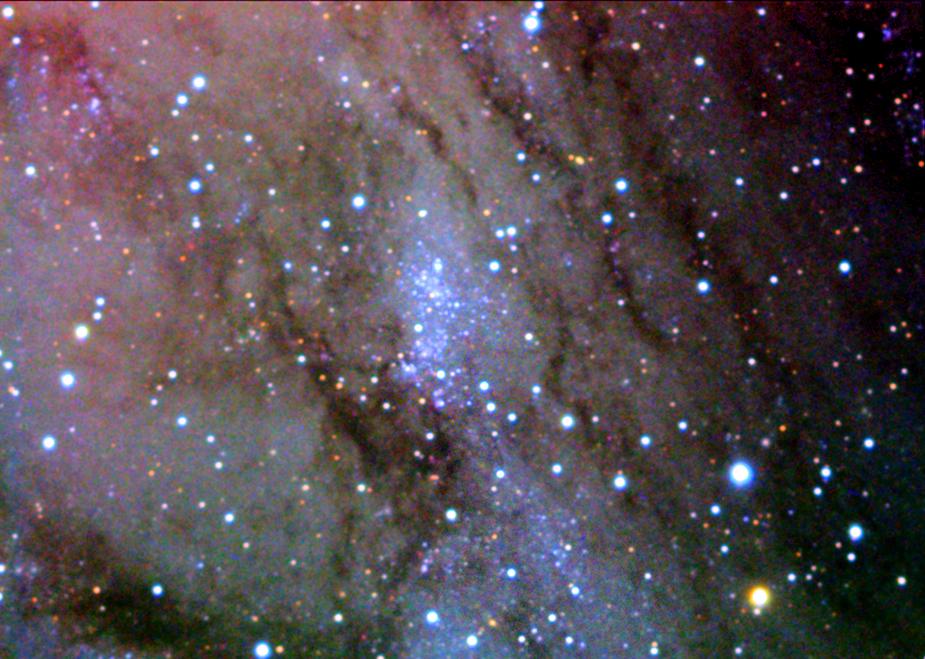dlw wrote:
Besides lots of super nova remnant nebulae, here is a greenish nebula(?) near the upper right corner.
Color is always a tricky business in pictures like this. A greenish nebula could be green because of OIII emission, which is caused by very hot stars. Carefully calibrated RGB images of the Orion Nebula will actually show the inner part of it to be yellowish or yellow-green. The yellow color is caused by a combination of blue-green OIII emission and red Ha emisson.
However, an interesting possibility is that the green color may actually be a signature of red giant stars. In a carefully calibrated RGB image, red giant stars should look yellow-orange. Since I couldn't see any obviously yellow-orange stars in NGC 2403, but I could see several yellow-green ones, I have to wonder if these greenish stars might possibly be red giants or supergiants. (interestingly, the yellow-green objects seem to be found only on the right side of the picture, which strengthens the probability that this is some kind of photographic effect.)
There are several nebulae with distinct, as opposed to fuzzy, boundaries. What does that imply?
Actually, the entire picture consists of parts that are sharp and extremely well-resolved and parts that are much fuzzier. The sharp parts were taken by the Hubble Telescope. The fuzzy parts were imaged by the Subaru Telescope only. The color data is probably mostly from the Subaru Telescope, although this is not absolutely certain.
There is an interesting bright blueish nebula on the lower right. I assume the stars are in the foreground. Is there anything unusual about that nebula?
The blue color suggests a star cluster or an association with a high density of A- and B-type stars, but a lack of O-type stars. Alternatively, there may simply be a lack of gas in here, so that the O-type stars have nothing to ionize. My guess, however, is that we are seeing a large rich association of mostly A- and B-type stars. You may compare this region with NGC 206 in the Andromeda Nebula, which contains many A-and B-type stars but little gas:
NGC 206 in the Andromeda Galaxy. Photo: Carsten A. Arnholm.
Also look at this image of the Eta Carina region on the right and the rich star cluster NGC 3532 on the left:
NGC 3532 consists mostly of A-type stars. The cluster has no gas and is therefore not linked to any nebulosity. Photo: Bill Christie.
Is there more that can be said about the bright super nova on the left ?
There is some more information about the supernova (SN 2004dj) here:
http://www.supernovae.net/sn2004/sn2004dj.html
A few things are immediately obvious. The supernova is not exceedingly bright. The galaxy, NGC 2403, is about half as bright as the Milky Way, and the supernova is nowhere near as bright as the galaxy.
The supernova is apparently of Type IIP. "Type II" generally means that there is hydrogen in the spectrum of the supernova, and it also usually means that this is an explosion of a massive star undergoing core collapse because it has built up a dead iron core. The "P" probably means that the supernova is somewhat peculiar. (EDIT: I take back the "peculiar" bit. See neufer's post.)
Near the upper left is an interesting "ring" with an object in the precise center; another remnant?
I'm not quite sure which object you mean. In any case, we seem to have "moved out of Hubble territory" and "into Subaru only territory", so the resolution isn't great, making it harder to judge what we are seeing. Personally, I think that the pink semicircle with a small isolated object inside it looks like a likely supernova remnant. The pink "halo object" which appears to be filled with something grayish looks mostly strange to me, and I can't guess what it is. Possibly a photographic artifact.
There is also a curious nebula in the upper left corner with a greenish center.
Okay, that appears to be what I called a pink halo object with a grayish interior. I think it looks strange, and I would guess that it might be a photographic artifact.
Ann
 NGC 2403 in Camelopardalis
NGC 2403 in Camelopardalis






